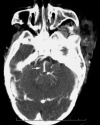Intracranial vascular anomalies in patients with periorbital lymphatic and lymphaticovenous malformations
- PMID: 17297008
- PMCID: PMC7977401
Intracranial vascular anomalies in patients with periorbital lymphatic and lymphaticovenous malformations
Abstract
Background and purpose: The purpose of this study was to determine the nature, incidence, and radiologic appearance of intracranial vascular anomalies that occur in association with periorbital lymphatic malformation (LM) and lymphaticovenous malformation (LVM).
Materials and methods: We retrospectively reviewed clinical records and imaging studies of 33 patients ranging in age from the neonatal period to 39 years (mean age, 5.1 years; median age, 1.0 year) who were evaluated for orbital LM or LVM at our institution between 1953 and 2002. Imaging studies, including CT, MR imaging, and cerebral angiograms, were evaluated by 2 radiologists to determine morphologic features of orbital LM and to identify associated noncontiguous intracranial vascular and parenchymal anomalies, including arteriovenous malformations (AVM), cerebral cavernous malformations (CCM), developmental venous anomalies (DVA), dural arteriovenous malformations (DAVM), and sinus pericranii (SP).
Results: The malformation was left-sided in 70% of patients. Twenty-two patients (70%) had intracranial vascular anomalies: DVA (n = 20; 61%), CCM (n = 2; 6%), DAVM (n = 4; 12%), pial AVM (n = 1; 3%), and SP (n = 1; 3%). Arterial shunts were present in the soft tissues in 2 patients (6%). Three patients had jugular venous anomalies. Three patients (9%) had cerebral hemiatrophy, 2 (6%) had focal cerebral atrophy, and 2 had Chiari I malformation.
Conclusions: Intracranial vascular anomalies, some of which are potentially symptomatic and require treatment, are present in more than two thirds of patients with periorbital LM. Initial imaging of patients with orbital LM should include the brain as well as the orbit.
Figures







Similar articles
-
Combined venous lymphatic malformations of the orbit (so-called lymphangiomas). Association with noncontiguous intracranial vascular anomalies.Ophthalmology. 1998 Jan;105(1):176-84. doi: 10.1016/s0161-6420(98)92058-9. Ophthalmology. 1998. PMID: 9442796
-
Cerebral Cavernous Malformations, Developmental Venous Anomaly, and Its Coexistence: A Review.Eur Neurol. 2020;83(4):360-368. doi: 10.1159/000508748. Epub 2020 Jul 30. Eur Neurol. 2020. PMID: 32731220 Review.
-
A review of extraaxial developmental venous anomalies of the brain involving dural venous flow or sinuses: persistent embryonic sinuses, sinus pericranii, venous varices or aneurysmal malformations, and enlarged emissary veins.Neurosurg Focus. 2018 Jul;45(1):E9. doi: 10.3171/2018.5.FOCUS18107. Neurosurg Focus. 2018. PMID: 29961384 Review.
-
The putative role of the venous system in the genesis of vascular malformations.Neurosurg Focus. 2009 Nov;27(5):E9. doi: 10.3171/2009.8.FOCUS09161. Neurosurg Focus. 2009. PMID: 19877799 Review.
-
Infratentorial Developmental Venous Abnormalities and Inflammation Increase Odds of Sporadic Cavernous Malformation.J Stroke Cerebrovasc Dis. 2019 Jun;28(6):1662-1667. doi: 10.1016/j.jstrokecerebrovasdis.2019.02.025. Epub 2019 Mar 14. J Stroke Cerebrovasc Dis. 2019. PMID: 30878367
Cited by
-
Real-time MRI-guided percutaneous sclerotherapy of low-flow head and neck lymphatic malformations in the pediatric population - a stepwise approach.Pediatr Radiol. 2017 May;47(6):755-760. doi: 10.1007/s00247-017-3789-x. Epub 2017 Feb 17. Pediatr Radiol. 2017. PMID: 28213627
-
Developmental venous anomalies of the brain in children -- imaging spectrum and update.Pediatr Radiol. 2016 Mar;46(3):394-406; quiz 391-3. doi: 10.1007/s00247-015-3525-3. Epub 2016 Jan 21. Pediatr Radiol. 2016. PMID: 26795616 Review.
-
Orbital masses: CT and MRI of common vascular lesions, benign tumors, and malignancies.Saudi J Ophthalmol. 2012 Oct;26(4):373-83. doi: 10.1016/j.sjopt.2012.08.001. Saudi J Ophthalmol. 2012. PMID: 23961022 Free PMC article.
-
A clinical update and radiologic review of pediatric orbital and ocular tumors.J Oncol. 2013;2013:975908. doi: 10.1155/2013/975908. Epub 2013 Mar 12. J Oncol. 2013. PMID: 23577029 Free PMC article.
-
Cerebrofacial venous anomalies, sinus pericranii, ocular abnormalities and developmental delay.Interv Neuroradiol. 2012 Jun;18(2):153-7. doi: 10.1177/159101991201800205. Epub 2012 Jun 4. Interv Neuroradiol. 2012. PMID: 22681729 Free PMC article.
References
-
- Katz SE, Rootman J, Vangveeravong S, et al. Combined venous lymphatic malformations of the orbit (so-called lymphangiomas). Association with noncontiguous intracranial vascular anomalies. Ophthalmology 1998;105:176–84 - PubMed
-
- Greene AK, Burrows PE, Smith L, et al. Periorbital lymphatic malformation: clinical course and management in 42 patients. Plast Reconstr Surg 2005;115:22–30 - PubMed
-
- Coll GE, Goldberg RA, Krauss H, et al. Concomitant lymphangioma and arteriovenous malformation of the orbit. Am J Ophthalmol 1991;112:200–05 - PubMed
-
- Graeb DA, Rootman J, Robertson WD, et al. Orbital lymphangiomas: clinical, radiologic, and pathologic characteristics. Radiology 1990;175:417–21 - PubMed
MeSH terms
LinkOut - more resources
Full Text Sources
Medical
